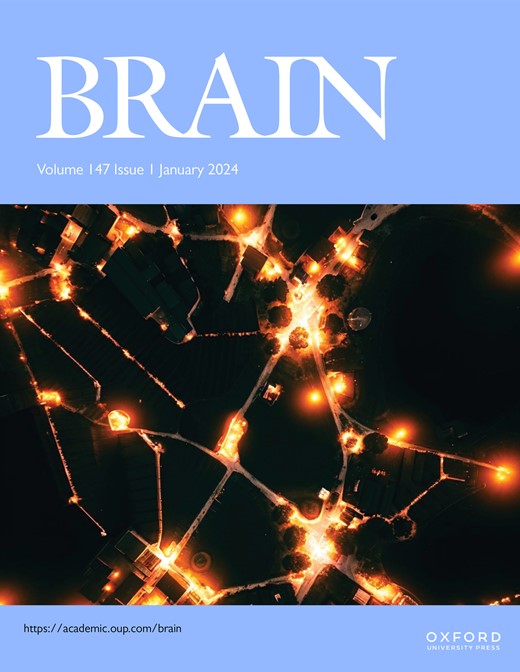Spreading depolarization triggers pro- and anti-inflammatory signalling: a potential link to headache
IF 10.6
1区 医学
Q1 CLINICAL NEUROLOGY
引用次数: 0
Abstract
Cortical spreading depolarization (CSD), the neurophysiological event believed to underlie aura, may trigger migraine headaches through inflammatory signaling that originates in neurons and spreads to the meninges via astrocytes. Increasing evidence from studies on rodents and migraine patients supports this hypothesis. The transition from pro-inflammatory to anti-inflammatory mechanisms is crucial for resolving inflammation. However, the resolution of inflammation in the context of CSD and migraine headaches remains poorly understood. This study aims to elucidate the progression of post-CSD inflammatory signaling and its resolution in neurons, astrocytes, and microglia in mouse brains. CSD was triggered optogenetically or by pinprick. HMGB1 release, caspase-1 activation, and cell-specific activation of NF-κB pairs, along with ensuing transcriptomic changes, were evaluated using immunofluorescence, Western blotting, co-immunoprecipitation, FRET analysis, and cell-specific transcriptomics. Our findings indicate that after the initial burst, HMGB1 release from neurons ceased, and caspase-1 activation, which peaked 1-hour post-CSD, diminished within 3-5 hours. This suggests that pro-inflammatory stimuli driving inflammatory signaling decreased within hours after CSD. Pro-inflammatory NF-κB p65:p50 pairs, along with anti-inflammatory cRel:p65 pairs, were detected in astrocyte nuclei shortly after CSD. However, 24 hours post-CSD, the former had disappeared while the latter persisted, indicating a shift from pro-inflammatory to anti-inflammatory activity in astrocytes. Pathway analysis of cell-specific transcriptomic data confirmed NF-κB-related pro-inflammatory transcription in astrocytes 1-hour post-CSD, while no such activity was observed in neurons. Detailed transcriptomic analysis with Bayesian cell proportion reconstruction revealed that microglia exhibited transcriptional changes trending towards an anti-inflammatory profile, along with upregulation of several chemokines and cytokines (e.g., TNF). This suggests that microglia may play a role in supporting the inflammatory responses in astrocytes through the release of these mediators. The upregulation of genes involved in chemotaxis (e.g., Ccl3) and spine pruning (e.g., C1q) in microglia implies that microglia may contribute to synaptic repair, while inflammatory signaling in astrocytes could potentially modulate meningeal nociceptor activity through an extensive astrocyte endfeet syncytium abutting subarachnoid and perivascular spaces although direct evidence remains incomplete. This nuanced understanding of the inflammatory response in CNS cell types highlights the intricate cellular interactions and responses to CSD. Following a single CSD, distinct transcriptomic responses occur in neurons, astrocytes, and microglia, driving inflammatory and anti-inflammatory responses, potentially contributing to headache initiation and resolution.扩展去极化触发促炎和抗炎信号:与头痛的潜在联系
皮层扩张性去极化(CSD),一种被认为是先兆基础的神经生理事件,可能通过炎症信号引发偏头痛,炎症信号起源于神经元,通过星形胶质细胞扩散到脑膜。对啮齿动物和偏头痛患者的研究越来越多的证据支持这一假设。从促炎到抗炎机制的转变是解决炎症的关键。然而,在CSD和偏头痛的背景下,炎症的解决仍然知之甚少。本研究旨在阐明小鼠脑内神经元、星形胶质细胞和小胶质细胞中csd后炎症信号的进展及其分解。CSD通过光遗传学或针刺触发。利用免疫荧光、Western blotting、共免疫沉淀、FRET分析和细胞特异性转录组学来评估HMGB1释放、caspase-1激活和NF-κB对的细胞特异性激活,以及随后的转录组学变化。我们的研究结果表明,在初始爆发后,神经元中HMGB1的释放停止,caspase-1的激活在csd后1小时达到峰值,在3-5小时内减弱。这表明促炎刺激驱动炎症信号在CSD后数小时内减少。促炎NF-κB p65:p50对和抗炎cRel:p65对在CSD后星形胶质细胞核中被检测到。然而,csd后24小时,前者消失,而后者持续存在,表明星形胶质细胞的活性从促炎向抗炎转变。细胞特异性转录组数据的通路分析证实,csd后1小时星形胶质细胞中存在NF-κ b相关的促炎转录,而神经元中没有观察到这种活性。贝叶斯细胞比例重建的详细转录组学分析显示,小胶质细胞的转录变化倾向于抗炎,同时一些趋化因子和细胞因子(如TNF)上调。这表明小胶质细胞可能通过释放这些介质在星形胶质细胞中支持炎症反应中发挥作用。参与小胶质细胞趋化性(如Ccl3)和脊柱修剪(如C1q)的基因上调表明,小胶质细胞可能有助于突触修复,而星形胶质细胞中的炎症信号可能通过广泛的星形胶质细胞终足合胞体邻近蛛网膜下腔和血管周围间隙调节脑膜伤害受体活性,尽管直接证据尚不完整。这种对中枢神经系统细胞类型炎症反应的细致理解强调了复杂的细胞相互作用和对CSD的反应。单一CSD发生后,不同的转录组反应发生在神经元、星形胶质细胞和小胶质细胞中,驱动炎症和抗炎反应,可能有助于头痛的发生和消退。
本文章由计算机程序翻译,如有差异,请以英文原文为准。
求助全文
约1分钟内获得全文
求助全文
来源期刊

Brain
医学-临床神经学
CiteScore
20.30
自引率
4.10%
发文量
458
审稿时长
3-6 weeks
期刊介绍:
Brain, a journal focused on clinical neurology and translational neuroscience, has been publishing landmark papers since 1878. The journal aims to expand its scope by including studies that shed light on disease mechanisms and conducting innovative clinical trials for brain disorders. With a wide range of topics covered, the Editorial Board represents the international readership and diverse coverage of the journal. Accepted articles are promptly posted online, typically within a few weeks of acceptance. As of 2022, Brain holds an impressive impact factor of 14.5, according to the Journal Citation Reports.
 求助内容:
求助内容: 应助结果提醒方式:
应助结果提醒方式:


